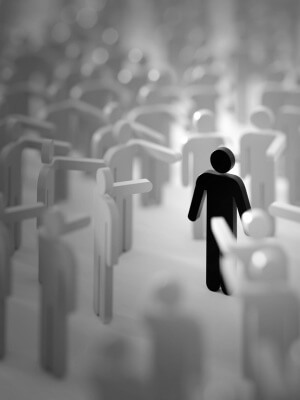
This content is protected against AI scraping.

Social media algorithms, aided by AI, are creating an unprecedented level of groupthink.
Well friends, I usually blog about the positive and the practical, but today I’m writing a long post about something I feel very strongly about. You can read about practical and positive reactions to all this in my post, “How to Be an Outlier.”
I’ve been thinking about this excellent blog post by Alex Morrell, “The Age of Average,” ever since I read it. Morrell discusses the overwhelming sameness of tastes in art, design, book titles, and even women’s faces.
What’s causing all this? In the past, we were influenced by TV, magazines, and friends; now, we’re influenced night and day by popular opinion, strained through the algorithms of social media.
“Then stop spending time on social media, Bryn,” you might say. I don’t think it’s practical for any writer to stay off social media, so it’s fortunate that I enjoy connecting with people through it. I do limit my time there. But the influence I’m talking about would be true no matter what, because news outlets, writers, designers, and decision-makers are deeply influenced by social media.
Now, my taste in books, movies, and TV, my personal style, and my thoughts don’t always have to be different from other people’s…but they do need to be mine. And in this era, if we’re not careful, we won’t even know what we like or what we believe.
Is today’s conformity as bad as conformity in the 1950s?
In the U.S., the 1950s are the period most associated with conformity. It evokes strict gender roles, repressive structures and rules of etiquette, neat suburban lawns, and the desire for new cars and new appliances.
But our idea of the prosperity and conformity of the 1950s is a very white idea, and the 50s, with its Beat poetry, cool jazz, and bus boycotts, wasn’t as conformist as we often think.

There’s no way to say whether our current era is more conformist than the 1950s. We can get good perspectives by talking with people aged 70 or older, but even then, individual experiences vary so much. But social media sites by nature are, as Bo Burnham has said, “trying to colonize every second of your life,” and they are colonizing other companies, the arts, politics, and philosophy in the process. The pervasive influence of popular opinions, strained through constantly self-“improving” algorithms designed to keep us glued to our screens as long as possible, are creating the New Conformity.
3 Examples of Conformity
1. Absolutely Ridiculous Social Media Pile-Ons
I’ve been on Twitter since 2008 (2009 with my current account). It’s always been a great place for writers to talk to other writers. It’s also been a place for the biggest, stupidest outbreaks of public shaming imaginable. I’m not worried about anyone facing opprobrium when they’ve been vicious or have harmed others, but as you’ll see from these examples, the New Conformity flattens moral outrage—with small offenses enraging people at least as much as atrocities—and creates confusion between “different” and “wrong” (the former being frequently labeled as “cringe.”)

Here are a few of the offenses that have led to widespread, vicious bullying on Twitter:
- a book editor saying they felt sad when declining too-short manuscripts
- a woman saying that she enjoyed drinking coffee with her husband every morning
- a writer and altruistic kidney donor pursuing what appeared to me to be a legitimate copyright infringement claim (the Bad Art Friend discourse)
- a woman saying she was going to make some chili and bring it to the young men next door
While we’re at it, here are a few of the offenses that have led to TikTok bullying:
- sharing a fun pitch to be a member of the Saturday Night Live cast (here’s Jake Novak writing about that experience)
- referring to a moderately priced purse—a gift from a loving father—as a “luxury bag”
- being an 11-year-old with a speech impediment
So, what the hell is going on here? In each case, hundreds of people are rushing to protect a super-orthodoxy that codifies everything in their lives. I’ll try to break down these examples of conformity.
That editor’s literal job, or at least part of it, is gatekeeping; according to the conformist ethos of liberal or “progressive” Twitter, that means they’re probably bad. Yeah, conformity doesn’t allow for a lot of nuance, and for good reason: nuanced, complex thinking in and of itself is a threat to conformity.
That wife having coffee with her husband is clearly happy and content; that must mean she has gotten unfair advantages. Twitter is used most often for complaining, so she also stepped out of line by using it to express simple gratitude.
On social media, declaring that the system needs to change and everything is the fault of billionaires is conformist. However, kind acts that actually make a difference, such as donating a vital organ or bringing food to the neighbors, are more out of the ordinary and therefore pose a threat.
Approving of yourself—say, by talking about your kidney donation, or saying you might be a good SNL cast member—is a clear and present danger to the New Conformity. You don’t get to decide for yourself that you’re good. You have to hope that the public, and the algorithms, decide that.
The New Conformity means that we must all share a definition of “luxury”—and of just about everything else, for that matter. If you call a bag a “luxury bag” when it’s not one of the approved brands, people will bully you for it so that you’ll learn the proper shared definition.
Despite the sheer absurdity of these public shaming events, they do tremendous harm to their targets. They often include indirect or direct suggestions that the person should commit suicide. People spiral down into depression and despair. They withdraw, going private, or delete their accounts. Sometimes, they feel unsafe in their day-to-day life. Naturally, they do harm to everyone else who witnesses them as well, as they are meant to, because they create a constant state of anxiety. We wonder, What will happen to us if we don’t conform enough?
When we participate in the mass bullying of anyone who hasn’t said or done anything horrible, but who challenges the New Conformity, we may feel a sense of moral superiority despite the fact that we are actively making the world worse. We feel we are playing the part of white blood cells, getting together to attack and destroy harmful viruses, when in fact, we are playing the part of cancer. (We also feel gleeful camaraderie with our fellow bullies, as bullies always do.)
2. The Age of Instagram Face
Recently, I learned that in the past year or two, buccal fat removal surgery has skyrocketed in popularity, driven to a great degree by Instagram and TikTok. You might not know what buccal fat is, and if that’s the case, good for you, and sorry! It’s the natural fat in one’s cheeks that give the face a rounder look. Buccal fat removal makes cheeks look hollow. Because we all lose some of that fat as we age, this surgery makes people look older. There’s nothing wrong with that, but it is paradoxical, given that BeautyTok also spreads terror of natural aging.
Many runway models in the early 2000s had lovely round faces. Devon Aoki and Lily Cole, shown below, are two examples. And if you’re at all observant and relatively free from conformity bias, you know that all face shapes look great.



The platforms themselves may enforce conformity in beauty standards. In 2020, a leak of a TikTok memo confirmed that TikTok suppressed posts from people with “abnormal body shapes,” “ugly facial looks” (remarkably, the memo went into a lot of detail about this), “dwarfism,” “obvious beer belly,” “too many wrinkles,” “eye disorders,” and other physical traits. I think it would be naive to think this hadn’t been refined further since, or to think Instagram’s algorithm doesn’t promote conventionally beautiful users in similar ways.
AIs can be used to synthesize conventional beauty standards so that algorithms can hide less conventionally attractive people. In fact, a recent TikTok trend has people trying out AIs that rank attractiveness on a scale and posting results. About one third of TikTok users are ages 10 to 19 (source here), and to me, subjecting children to all this feels like pouring poison straight into their veins.
Whew, let’s talk about something a little less dire…
3. The Bleak Sameness of Home Decor
Alex Morrell’s article that I linked to above does a wonderful job of what can be called “The Brooklyn Look” or “International AirBnB Style.” I had been thinking about home decor conformity ever since my last visit to my parents’ house. One of the upstairs bedrooms at their house is the angel room, with angels on the comforter, as wall decor, and more. Another room has a lighthouse theme. It’s charming, quirky, and them.
I’m not saying everyone should have themed bedrooms, but when I look for home decor ideas on Pinterest or Houzz or anywhere, I don’t see a lot that makes me smile. I was talking about this on Twitter, asking, “When did decorating get so serious?”
I thought this response from the author Adriana Anders nailed it exactly:

It’s gotten extremely generic. No one has kid art or shit they painted or some bright afghan they bought in college and loved. Like young women’s faces, I worry that decor is being streamlined by social media.
Adriana Anders
There has been, at least, a small TikTok interior decorating trend called “cluttercore.” Now that made me smile. Wow, so I can have stuff I like sitting around in my own place? Groundbreaking! But I get it, and I’m glad to see it. It’s a response to images of room after room with white or neutral walls, white or neutral upholstery or bedding, light wood, and maybe some joyless black and white artwork or some vaguely funereal vases and lamps, just to round out the look.





If someone loves this look, that’s great. I certainly don’t dislike it. Really, what’s to dislike? I’m not against home decor trends at all. I just feel like we need more of them.
If Instagram had been around in the 1990s, the home decor pictures would’ve shown us so many different looks. Tuscan farmhouse with fake stucco, like you live at the Olive Garden or certain Cheesecake Factories. English country with chintz and frills everywhere. Shabby chic. Contemporary glass and steel furniture, with the latest tech proudly displayed. Garden room/conservatory, complete with indoor wicker or wrought iron furniture. Flea market chic, a la Monica Geller’s apartment on Friends. Southwestern, Victorian, French country, every kind of wallpaper there is, sponge-painted walls, stenciled borders, primary color palettes, clubby hunter green/maroon/navy/dark wood combos, and animal print explosions. There were about a hundred different options for window treatments alone.





It’s not that there aren’t any other interior decorating trends now. It just seems like we always have a few looks crowding out everything else, just the way reboots and sequels crowd out original movies…just this depressing, embarrassing sameness everywhere.
I think this enforced sameness creates an incredible amount of anxiety because none of us were meant to fit into molds. For creative people to flourish, some resistance is necessary.
The algorithm-driven New Conformity is a threat to our individuality and humanity, and a heightened state of consciousness is our only opt-out.

What do you all think?
Are your experiences with social media similar or different from what I’ve been talking about here? Have you noticed other examples of conformity? Is it something you’ve been concerned about, too, or not so much? I’d love to hear your thoughts in the comments!
Thanks so much for reading, and keep on being your unique self!









Really, not sure what to think. My first thought: I can’t believe so many people use TikTok with its undeniable ties to China spying.
Just a starter….
Privacy is definitely a concern, especially with TikTok! Thanks for reading, Jacqui!
Great insight. My initial thoughts on your article make me think how it’s too easy to pile on or even silently join in with a concept, group think. Sadly, alternative ideas to the mob will get you cancelled. I think social media’s power and what an algorithm shows in feeds drives the narrative. I’ll be thinking more about this indeed.
It’s true, it’s really easy to pile on…or even accidentally pile on, if you don’t know a tweet is part of a larger conversation! And yeah, it’s a rough place for independent thought sometimes. Thanks for reading, and for commenting, Christina!
I deleted all my social media accounts about 18 months ago not because of conformity but because of the toxicity. I just got fed up with seeing the hate and division over (sometimes) petty issues. It was the best thing I ever did.
Thanks for that Dawn. Glad i’m not the only one. I did the same and it felt weird. It’s a world of insecurity with people trying to find something to lift themselves in their eyes, unfortunately the easiest way to do that is knock others down. That’s what I love about this site, Bryn only allows positive comments. It’s uplifting for me on WIP Wednesday when I go through and read Christina Boyds positive comments on every persons post. Here’s to higher consciousness!
I bet it felt good to get rid of those! To be honest, I go months without deleting a negative comment. I’ve been very lucky in terms of attracting positive and interesting people. And Christina Boyd is the BEST 🙂 YES, here’s to higher consciousness!
I get fed up too! I do think about that. I’m sure it brings a lot of serenity. I don’t think it’s practical for me to cancel everything because it’s useful as an author and independent contractor. But I’m severely limiting my social media time, which I didn’t do before! Thanks for commenting, Dawn!
I agree with you wholeheartedly. I am afraid of what it is doing to our upcoming generations. The conformity culture is also a large part of our school systems. Schools no longer encourage free thought and
creativity. Thank you for such a well written article.
Hi Valerie! I have no connections to our school systems, so that’s something I don’t know about at all. I do worry about what social media is doing to people’s brains, and younger people especially! Thanks for reading, and for commenting!
I understand what you are saying, Bryn, but I think AI algorithms merely empower trends that are basic to humanity. For most, the need for acceptance comes with conformity which is mindlessly easy, another major advantage. Catalogs exist to give people 3-5 selections that assure them they are conforming. On their own, how would they know if they are approved? Those with neither taste nor judgment not only fit in but they feel empowered to criticize, i.e., they become arbiters of things they know nothing about. Perhaps that is the only power they can know. I’m a real outlier here. To me a conforming life isn’t a life at all. One is living lockstep someone else’s life on their terms. What a waste. A question I hear often is ‘who gave you permission to do that?’ I also hear ‘you can’t do it that way.’ Groupthink to me indicates little or no ‘individual think’. Without a thought too many people fall in with a group and chant whatever is on the wind. I do not believe there are fewer creative individuals, just computer mass-produced conformists who are increasingly visible and vocal.
As a communal species, humans often find comfort in unity and conforming, seeking support from others as they navigate the challenges of life. But where does approval come from you ask? It comes from within, when the person fees a deep sense of satisfaction with the choices they make.
It’s important here to distinguish between an outlier and a counter-conformist. There is an ocean of differences between the two. Counter-conformists are still bound by the actions of conformists; they conform to the group of counter-conformists. A counter-conformist can be recognized by their judgements and critical views of conformists. They see them as inferior and as an opponent in some internal civil war within their minds.
You see, outliers, on the other hand, are mindfully independent thinkers who celebrate their oneness without any condemnation, or even comparisons at time, of others. They hold no prejudice and accept, and even celebrate those with different natures, for they would not be unique without them. Outliers are sui generis, Latin for of it’s own kind.
Carlton, I think that distinction between a counter-conformist and an outlier is so important. I gave up on my feelings of “if it’s popular, I can’t like it” when I graduated post-punk posturings and high school. I don’t need to be like everyone else or not like everyone else, but I do need to be myself! Thanks so much for the thoughtful post.
Hi Keith! I love what you’re saying here. This is really what the transcendentalists like Emerson and Thoreau were saying, and I’ve been thinking about them more and more. We need more creative individuals and more outliers. Thanks for reading, and I appreciate your comments!
Glad I painted over my sponge-painted walls.
Guess I shouldn’t have told the national writer’s group on twitter that their graphic incorrectly spelled Noes as No’s, even though it’s a pet peeve and they should know better. It’s already out there. It wasn’t meant as shame, but I realize it will be taken that way.
Haha, I kind of like sponge-painted walls, though! You know, if a national writers’ group has a typo on their logo, they probably do need to get that fixed. 🙂
I never really stopped to think about the sameness of home decor prior to reading this, but you are right. Every decor magazine has the same basic colorless sterol appearance. While I like the clean look it gives, it also feels very cold. How could someone be comfortable in that setting? I’ve made it a point not to make my home that way. From the Star Wars themed kitchen to the hand painted wall art, it is uniquely home.
All of that to say, this is great food for thought. Thank you for sharing these insights.
Hi Erin! Aww, I love it. I think what looks chic on Instagram and what feels happy and homey in real life are going to be different things for a lot of people. A Star Wars-themed kitchen and hand-painted wall art are such great reflections of personality! Thanks so much for posting. 🙂
I don’t like how many images on social media now claim to be photos when they are obviously AI images. I have seen many way too perfect animal pictured lately, where the animals are kissing or embracing each other. They are so fake, yet people love them. This polished view of nature could lead to some dangerous misunderstandings about the real world.
Hi Naomi! Oh God, I know exactly what you’re talking about. I just hate it. And I feel like so many people believe whatever they read and whatever they see. It’s disturbing, for sure! I’m glad you brought that up. Thanks for posting!
I agree with you…from all the curated photos to the very bland home decor. As a mom of three daughters it has been a long road of watching them try to emulate what they see in a fake world that has been thrust upon them as reality. I wish everyone could be themselves and see that their uniqueness is their ‘brand’. I feel it with writing though as well. I am writing a cozy mystery and it seems there are so many rules if I wish to get published. It impedes the writing process, it hold me back from what I really want to write. These formulas for life and creativity are suffocating. Thank you for bringing it to light.
Hi Sandi! It’s got to be hard to be a mom and see your daughters deal with unrealistic and stifling expectations. I know what it’s like to feel too confined by the “rules” of writing, too. This is a really great post. Thank you for sharing!
On the human-driven end of creative expression, I have to say that I would have hoped that technology by now would have produced a Harlem Renaissance of variety in tastes and a depth of progress.
Unfortunately, we’re in a world that’s driven all too much by big lobbies, corporations, and self-serving political groups that seem ever intent on “over-standardizing.” Whether it be building codes, vehicle specifications, product dimensions, student curriculums/test standards, or PANTONE colors of the year.
With products, big companies like Amazon seek out the same component suppliers or knockoff-specialists and kick out identical products under their own “value” label, that conveniently gets flooded with fake positive reviews. A funny YouTube vid titled “What Shopping on Amazon Feels Like” by Ryan George has a funny take on this.
As for online content, I also am bothered that people have too easily cast-off civility behind their anonymity (they aren’t mutually exclusive), making for troubling online communities where trollers or hired hands can run wild and be merciless without repercussion. It’s too Wild-West for being nearly 30 years since search became mainstream. Another funny commentary can be found in the YouTube vid titled “Chappelle’s Digital World – Chappelle’s Show” (note: “mature content”).
As for variety, if only there was a way to effectively stroll the internet as one once did through directories on Yahoo; but that’s not really possible with all the content out there, and that’s part of the problem. It would be nice if there were some sort of curation, moderation and exploratory means of finding the nuggets of gold on the internet instead of FAANG’s search boxes or endless scroll of bland.
I think AI actually has a lot of potential and would encourage folks to experiment with Bard, Chat-GPT, and DALL-E. If you get good enough at prompting them, the output can be surprising and diverse. That said, the genie is out of the bottle on AI. Knowing company leaders trained to put earning/saving of a quick buck for the next quarter above all, creatives need to mobilize to ensure AI remains an augmentary tool by figuring out how it can complement what we do, and how we can continue to bring our unique gifts to the world rather than finding ourselves replaced.
Regrettably expression in this world has become a Lipton instant soup instead of the rich and varied stew it should be.
Chris! I love your post here. I’m a Ryan George fan, too…I know the video you’re talking about, and when I think about social media issues, I often think about this one too.
(Second reply because I accidentally hit reply too soon!) I love what you said about civility. And I’ve had that exact thought about culture…how I would’ve hoped there would be a Harlem Renaissance-type proliferation of tastes and styles and thought. Your Lipton instant soup metaphor is spot on! It’s funny, too, because in those beginnings of the internet that you’re talking about, it wasn’t image-driven and weirdos could find each other. I like your idea of some new ways of curation, too. 🙂 Great post!
Rock on, my dear. You are one amazing, smart, brave, invigorating woman. At almost seventy-seven, I want to be like you when I grow up. Your courage and tenacity makes me smile. I’m a little late on this comment but sure hope you get to see it. When is the next WIP…I’m anxious to share my outrageous thoughts.